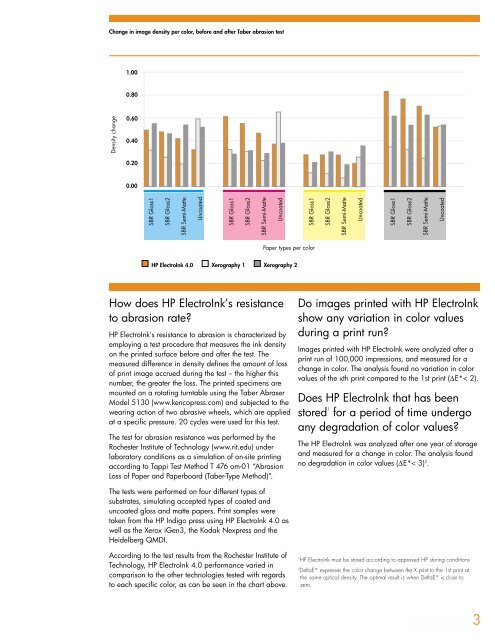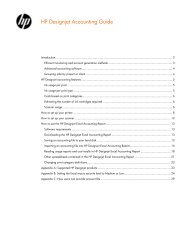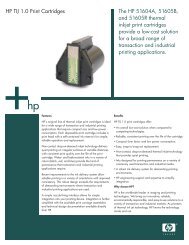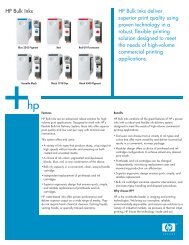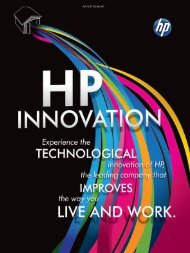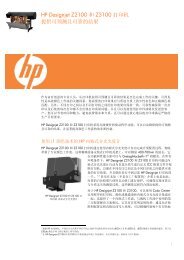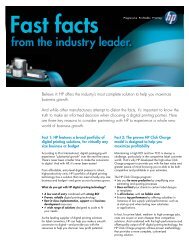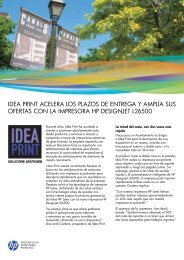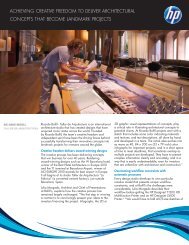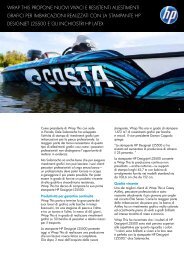HP ElectroInk Frequently Asked Questions - Hewlett Packard
HP ElectroInk Frequently Asked Questions - Hewlett Packard
HP ElectroInk Frequently Asked Questions - Hewlett Packard
You also want an ePaper? Increase the reach of your titles
YUMPU automatically turns print PDFs into web optimized ePapers that Google loves.
Change in image density per color, before and after Taber abrasion test<br />
Density change<br />
1.00<br />
0.80<br />
0.60<br />
0.40<br />
0.20<br />
0.00<br />
SBR Gloss1<br />
SBR Gloss2<br />
SBR Semi-Matte<br />
Uncoated<br />
How does <strong>HP</strong> <strong>ElectroInk</strong>’s resistance<br />
to abrasion rate?<br />
<strong>HP</strong> <strong>ElectroInk</strong>’s resistance to abrasion is characterized by<br />
employing a test procedure that measures the ink density<br />
on the printed surface before and after the test. The<br />
measured difference in density defines the amount of loss<br />
of print image accrued during the test – the higher this<br />
number, the greater the loss. The printed specimens are<br />
mounted on a rotating turntable using the Taber Abraser<br />
Model 5130 (www.kencopress.com) and subjected to the<br />
wearing action of two abrasive wheels, which are applied<br />
at a specific pressure. 20 cycles were used for this test.<br />
The test for abrasion resistance was performed by the<br />
Rochester Institute of Technology (www.rit.edu) under<br />
laboratory conditions as a simulation of on-site printing<br />
according to Tappi Test Method T 476 om-01 “Abrasion<br />
Loss of Paper and Paperboard (Taber-Type Method)”.<br />
Paper types per color<br />
The tests were performed on four different types of<br />
substrates, simulating accepted types of coated and<br />
uncoated gloss and matte papers. Print samples were<br />
taken from the <strong>HP</strong> Indigo press using <strong>HP</strong> <strong>ElectroInk</strong> 4.0 as<br />
well as the Xerox iGen3, the Kodak Nexpress and the<br />
Heidelberg QMDI.<br />
According to the test results from the Rochester Institute of<br />
Technology, <strong>HP</strong> <strong>ElectroInk</strong> 4.0 performance varied in<br />
comparison to the other technologies tested with regards<br />
to each specific color, as can be seen in the chart above.<br />
SBR Gloss1<br />
SBR Gloss2<br />
SBR Semi-Matte<br />
Uncoated<br />
<strong>HP</strong> <strong>ElectroInk</strong> 4.0 Xerography 1 Xerography 2<br />
SBR Gloss1<br />
SBR Gloss2<br />
SBR Semi-Matte<br />
Uncoated<br />
Do images printed with <strong>HP</strong> <strong>ElectroInk</strong><br />
show any variation in color values<br />
during a print run?<br />
Images printed with <strong>HP</strong> <strong>ElectroInk</strong> were analyzed after a<br />
print run of 100,000 impressions, and measured for a<br />
change in color. The analysis found no variation in color<br />
values of the xth print compared to the 1st print (∆E*< 2).<br />
Does <strong>HP</strong> <strong>ElectroInk</strong> that has been<br />
stored 1<br />
for a period of time undergo<br />
any degradation of color values?<br />
The <strong>HP</strong> <strong>ElectroInk</strong> was analyzed after one year of storage<br />
and measured for a change in color. The analysis found<br />
no degradation in color values (∆E*< 3) 2 .<br />
1 <strong>HP</strong> <strong>ElectroInk</strong> must be stored according to approved <strong>HP</strong> storing conditions<br />
2 DeltaE* expresses the color change between the X print to the 1st print at<br />
the same optical density. The optimal result is when DeltaE* is close to<br />
zero.<br />
SBR Gloss1<br />
SBR Gloss2<br />
SBR Semi-Matte<br />
Uncoated<br />
3


